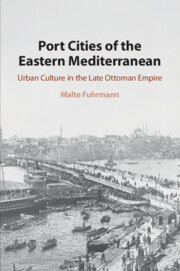Book contents
- Port Cities of the Eastern Mediterranean
- Port Cities of the Eastern Mediterranean
- Copyright page
- Contents
- Figures and Table
- Acknowledgments
- Part I Introduction
- Part II Constructing Europe
- Part III The City’s New Pleasures
- 8 Visiting, Strolling, Masquerading, Dancing
- 9 Staging Europeanness
- 10 Theater, the Civilizing Mission, and Global Entertainment
- 11 The One World of Workers of the Dramatic Arts
- 12 Beer Consumption and Production on Mediterranean Shores
- 13 Beer, the Drink of a Changing World
- Part IV Identities on the Mediterranean Shore
- Part V The End of the European Dream
- Part VI Europe and the Eastern Mediterranean Revisited
- Bibliography
- Index
8 - Visiting, Strolling, Masquerading, Dancing
The Consumers of Europeanism
from Part III - The City’s New Pleasures
Published online by Cambridge University Press: 09 October 2020
- Port Cities of the Eastern Mediterranean
- Port Cities of the Eastern Mediterranean
- Copyright page
- Contents
- Figures and Table
- Acknowledgments
- Part I Introduction
- Part II Constructing Europe
- Part III The City’s New Pleasures
- 8 Visiting, Strolling, Masquerading, Dancing
- 9 Staging Europeanness
- 10 Theater, the Civilizing Mission, and Global Entertainment
- 11 The One World of Workers of the Dramatic Arts
- 12 Beer Consumption and Production on Mediterranean Shores
- 13 Beer, the Drink of a Changing World
- Part IV Identities on the Mediterranean Shore
- Part V The End of the European Dream
- Part VI Europe and the Eastern Mediterranean Revisited
- Bibliography
- Index
Summary
The nineteenth century brought diversification to Eastern Mediterranean pastimes. Residents could visit neighbors and friends at home or meet them at the evening stroll along the waterside or main avenues. Especially as of the 1870s, commercial venues increased to large numbers. Especially the season from New Year to Carnival brought with them numerous receptions and balls as main sites of social prestige. Toward the new century, consumers increasingly expected music and dance opportunities to be on permanent offer through cafés. Especially balls served as loci to perform interethnic and international harmony. While participation in these leisure practices was not equally practiced by all denominational groups, with especially Muslims being underrepresented, there was no formal exclusion of any group, as acquired cultural capital was the main hurdle for taking part and profiting from these sociabilities.
- Type
- Chapter
- Information
- Port Cities of the Eastern MediterraneanUrban Culture in the Late Ottoman Empire, pp. 99 - 121Publisher: Cambridge University PressPrint publication year: 2020



